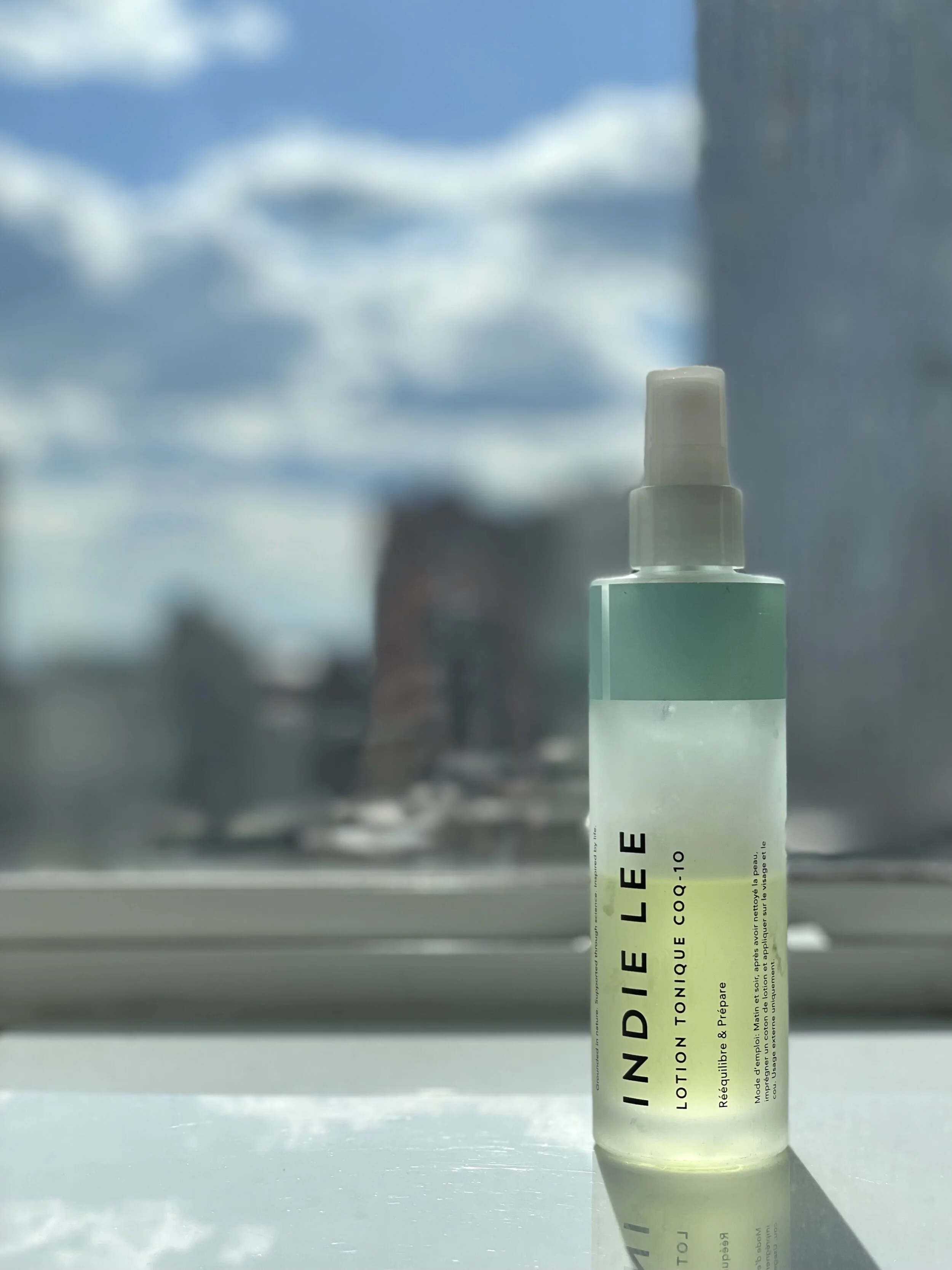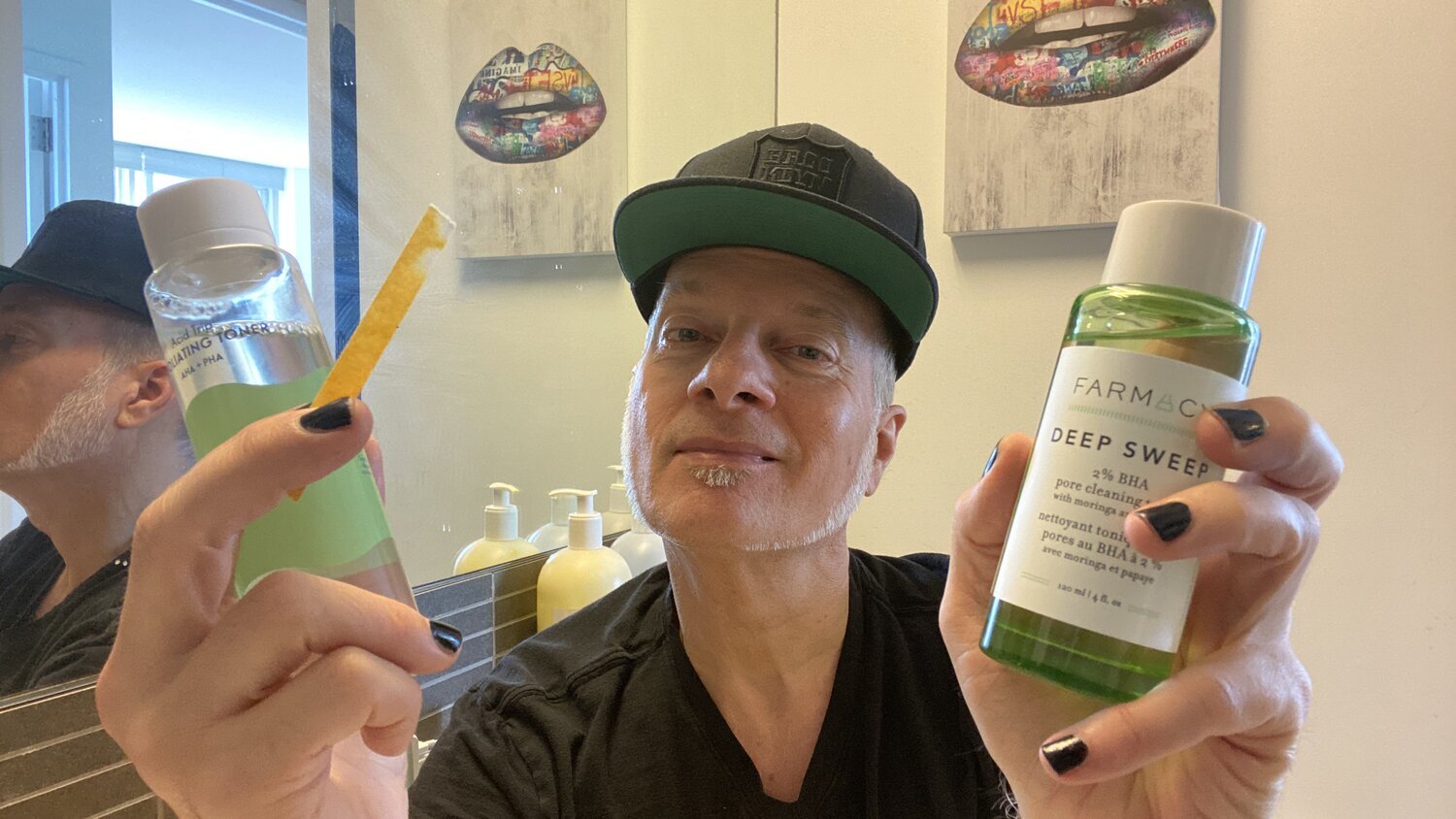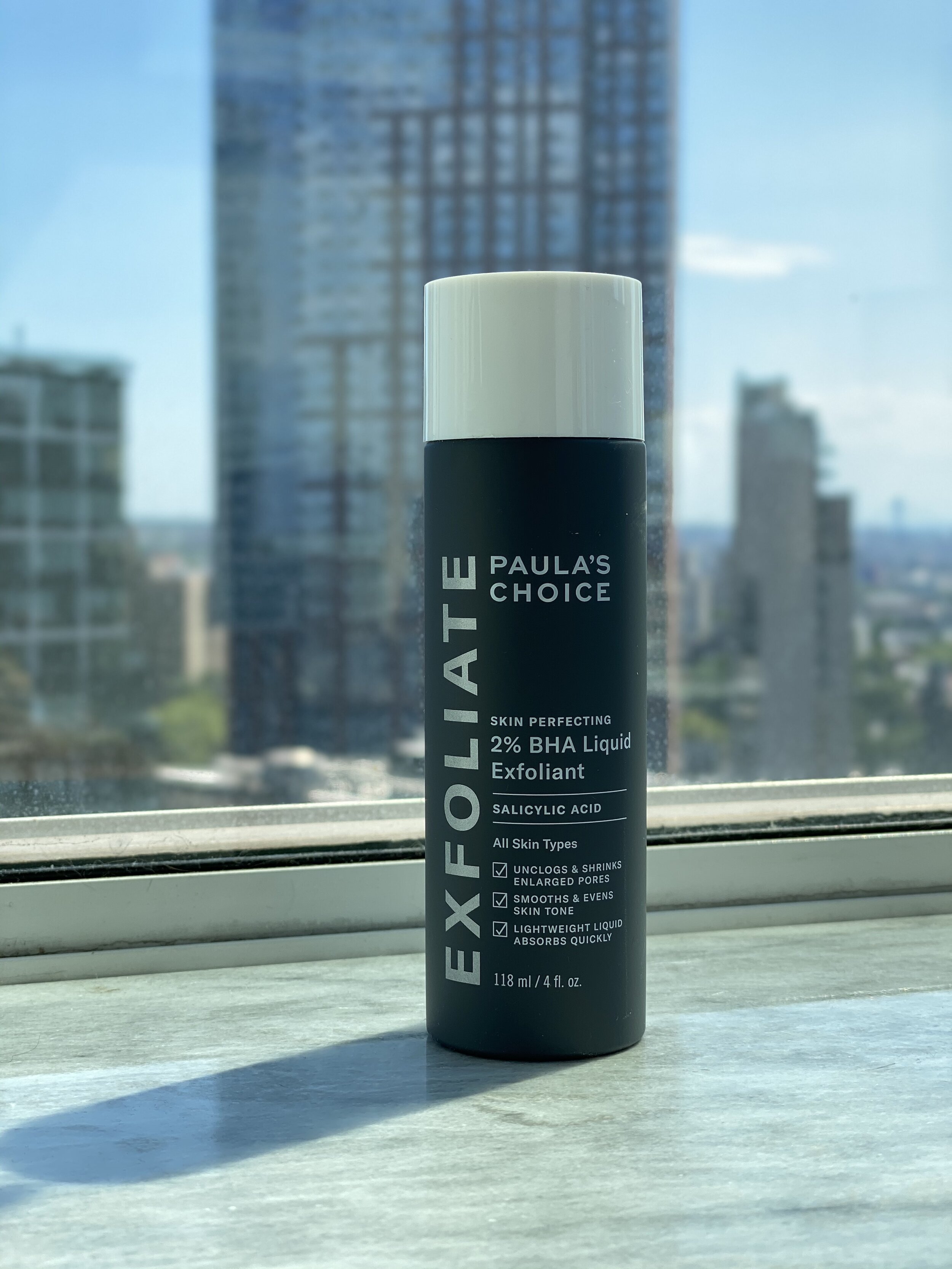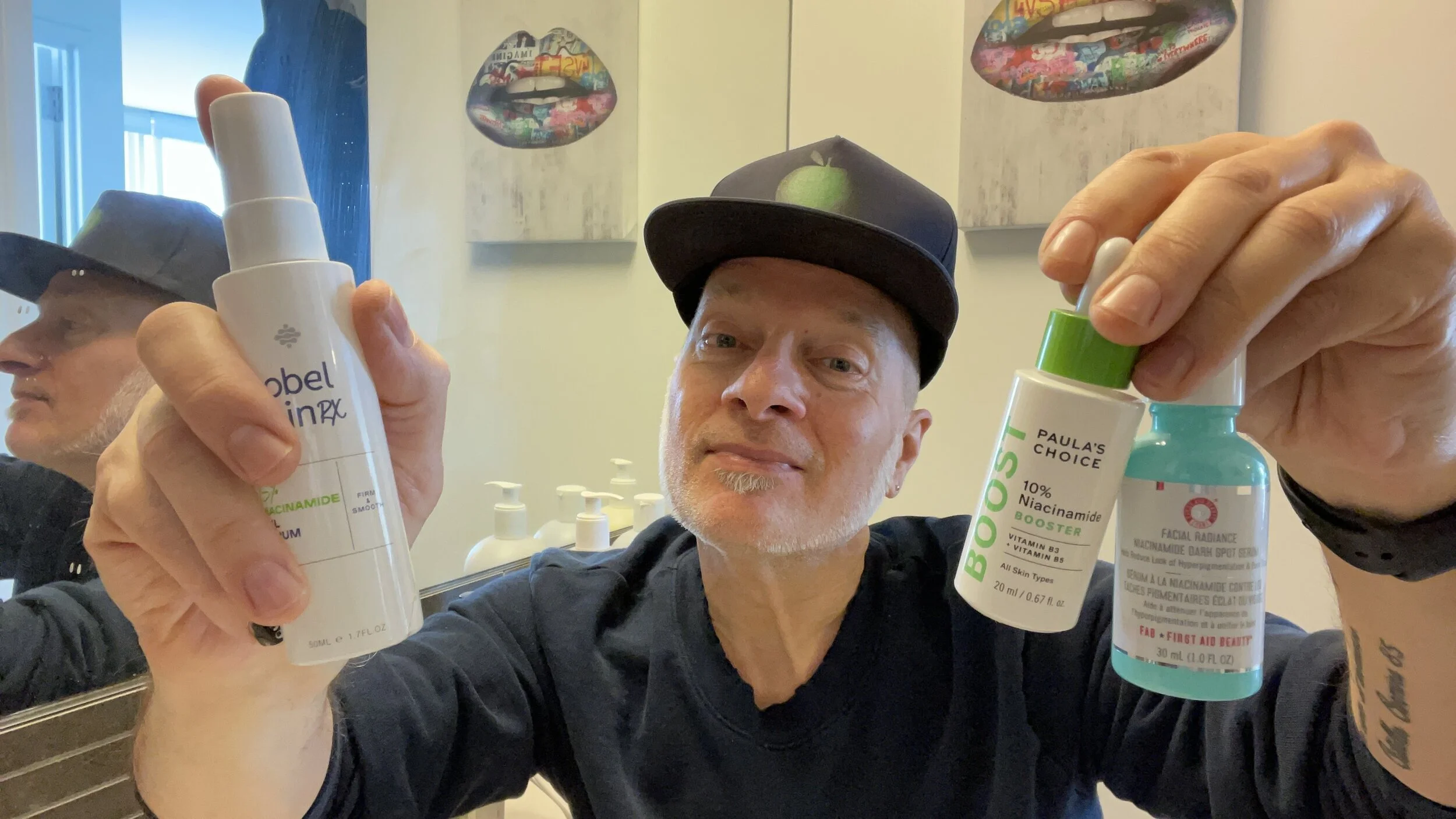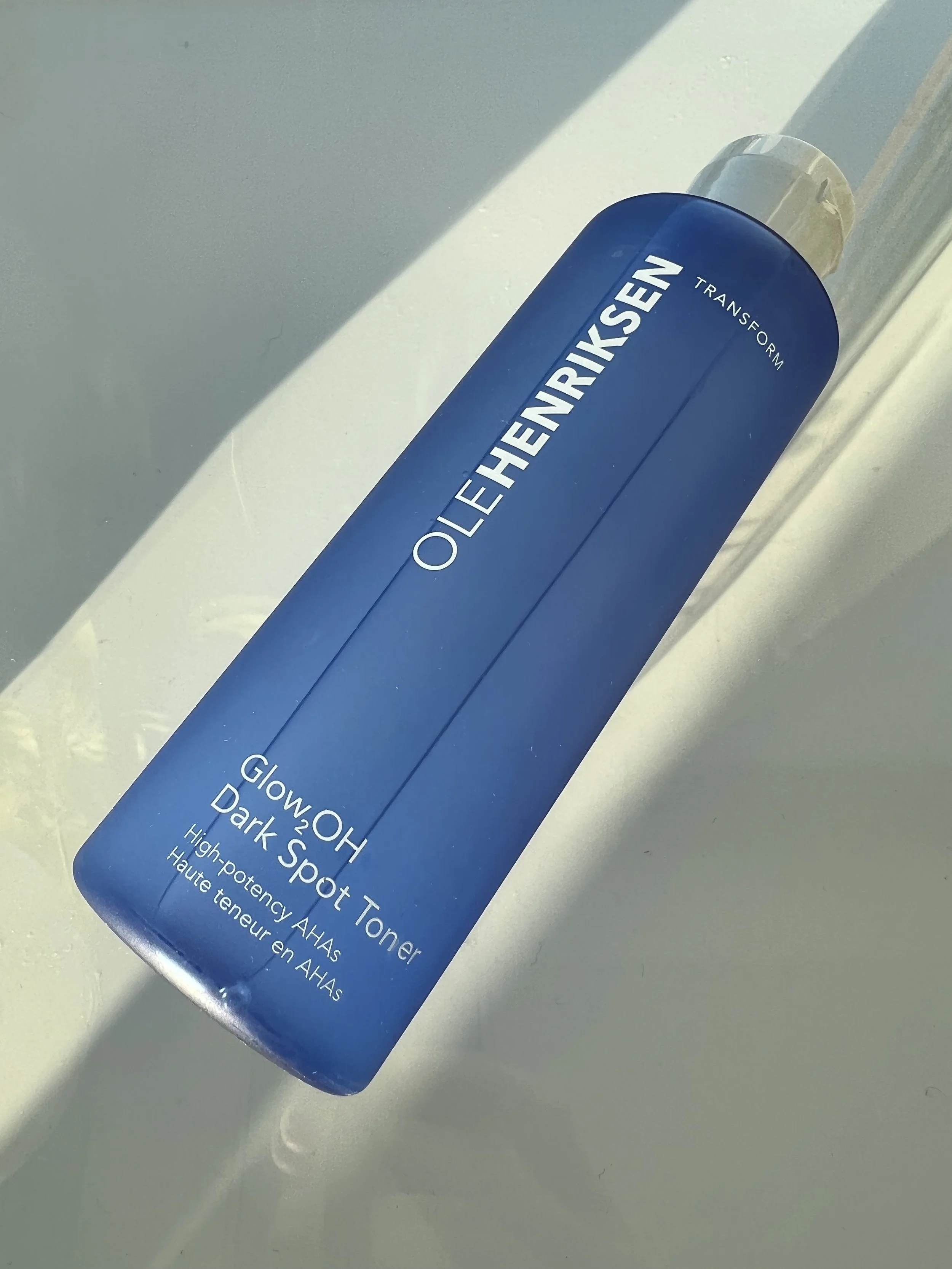PRODUCT REVIEW: GOOD MOLECULES GLYCOLIC EXFOLIATING TONER – BEST EXFOLIATING TONER, BEST GLYCOLIC ACID TONER FOR SENSITIVE SKIN
This product review was originally part of my blog article titled, Seasonal Skincare Transitioning: Treatment Toners I Love that Make Me Excited for Cold Weather – Best Exfoliating Toner, Best Toner with Glycolic Acid. You can catch the full piece here.
—
With the change of seasons here in New York City, I make a habit of switching up my skin care. I like to refer to it as “seasonal skincare transitioning.” As the seasons change, so does your skin — and your skin’s everyday needs.
I love switching up my skin care. And I love toners most of all!
The funny thing about toners is not all toners are created equal — or do the same thing. There are two major types of toners: hydrating toners and acid, or treatment toners. The two are not mutually exclusive; that is, you don’t use one or the other. While they’re both called toners, they have completely distinct purposes and benefits for the skin.
Every skincare routine, morning and evening, should consist of a hydrating toner — applied immediately following cleansing. Period. End of story. Hydration is a must, central to a K-beauty routine and IMO essential to a robust and healthy skincare regimen.
PRODUCT REVIEW: INDIE LEE COQ-10 TONER - BEST HYDRATING TONER, BEST ANTIOXIDANT TONER
A treatment toner, on the other hand, is formulated with any number of beneficial exfoliating acids — usually one or more actives from the class of AHA, BHA or PHA hydroxy acids. After employing a hydrating toner, if you want to use a treatment toner to exfoliate and boost skin’s desquamation process, you can.
There are so many things I love about skincare and how skincare products work with the skin. But there’s one entire skincare habit which, while popular, is quite out of control. And that’s exfoliation and the overuse of exfoliating treatments.
Unlike so much of what we do for our skin — including moisturizing, cleansing and protecting from sun damage — the one thing skin does pretty well on its own is what’s termed desquamation.
Every skin cell originating in the lower levels of the skin rises to the surface within 28 days, where it’s freed from the body — like pollen gently floating from wild poppy flowers and disappearing into the air over the horizon.
What Does Desquamation Mean and Why Does Desquamation Occur?
In short, desquamation is the fancy term for cell regeneration, cell death and exfoliation. More specifically, desquamation is the process by which the skin generates new skin cells and 28 days or so later, sheds them. Desquamation essentially encompasses the life cycle of a skin cell.
There’s an excellent, insightful piece on the Very Well Health website titled, Desquamation Process and the Outer Layer of Skin.
According to the health site Very Well Health:
Desquamation is the natural process in which skin cells are created, sloughed away, and replaced. The desquamation process happens in the outermost layer of the skin called the epidermis. The epidermis itself has four unique layers. Each of these layers plays a role in desquamation.
Skin Cells are Born
Sometimes called cell turnover, desquamation happens every second of the day, without you even noticing.
New skin cells are created in the stratum germinativum, which is the deepest layer of the epidermis. This layer is also called the basal layer.
Skin cells begin their life as a single layer of thick, column-shaped cells. These cells are responsible for creating every cell of your skin.
The cells in this layer divide. Half of them stay behind in the stratum germinativum. The other cells begin their migration to the skin's surface.
Cells Reach the Surface, Then Slough Off
The skin cells have reached their final destination — the stratum corneum. Once the cells arrive at this uppermost layer of the skin they are essentially dead.
The cells in the stratum corneum are very flat and tightly packed. These flat, dead cells continuously fall away as newer cells push their way to the surface. In this way, your skin is constantly renewing itself.
Where do all of those dead skin cells go? You might be surprised to know that most of the dust in your home is actually made up of dead skin cells.
The entire desquamation process, from cell birth to sloughing away, takes approximately 14 to 28 days.
Because the desquamation process is so efficient and methodical, I don’t believe skin needs or can generally tolerate daily exfoliation — whether chemical or physical. Even if your skin tolerates it, it doesn’t need it very often. In fact, our skin doesn’t need us to do anything when it comes to exfoliation.
For the record, I don’t use a chemical exfoliant — either a treatment toner or acid-powered serum — more than thrice weekly.
That said, the kind of exfoliation you can achieve with popular, iconic products like the Sunday Riley Good Genes All-In-One Lactic Acid Treatment or my personal fave Paula’s Choice Skin Perfecting 2% Bha Liquid Exfoliant helps to speed up the process of desquamation. Doing so, leaves the complexion free of dead skin. Dead skin cells aren’t doing you any favors.
PRODUCT REVIEW: PAULA’S CHOICE SKIN PERFECTING 2% BHA LIQUID EXFOLIANT – BEST TONER FOR OILY SKIN
Truth is, dead skin is simply not as reflective as fresh skin, meaning the natural build-up of dead surface skin cells can result in a lackluster complexion — the opposite of the coveted glass skin. Exfoliating treatments brighten the complexion by immediately removing dead skin cells so skin naturally glows. Even healthy skin can appear dull. And who wants that?
Dead surface skin cells also inhibit the penetration of topical skincare, meaning even the Vitamin C serums and best face creams with Retinol cannot be as effective as you want them to be. And the dead skin lingering on your face is the reason. The level of chemical exfoliation you get from a great treatment or acid toner is the perfect solution.
A caveat about physical exfoliation:
As is the case with skin care in general, not all exfoliating products are good for your skin. In fact, physical exfoliators, or face scrubs, can be quite aggressive on the skin and can scratch and otherwise damage the delicate skin barrier.
If you’re using a face scrub, please stop.
The Best Niacinamide Serums and Treatments
Always a terrific resource for skincare tips, education, insights and guidance, the Paula’s Choice website features an excellent article titled, Exfoliation: The Skin Care Step You Never Knew You Needed.
In the piece, the experts on the Paula’s Choice Research Team seek to educate on the differences between chemical and physical exfoliation and the dangers of using a scrub.
“Daily, gentle exfoliation with a leave-on product is a complete game-changer for every skin type and skin concern. Adding this one step to your routine is the fastest, most effective way to get radiant, smooth, hydrated, blemish-free, even-toned skin.
“AHA (alpha hydroxy acid) and BHA (beta hydroxy acid) exfoliants help skin shed dead cells more quickly, the way it did before age and environmental factors began to slow that process. These acids are also the gentlest way to exfoliate, and they nourish and transform the look of your skin in ways no brush or scrub can.
“Despite the popularity of facial scrubs, most are too harsh and abrasive; they can cause tiny tears that damage skin over time, even if that damage isn’t immediately visible. Even the best scrubs, while they do have benefits, can’t produce the same results as an AHA or BHA exfoliant.”
While AHA and BHA-powered chemical exfoliators are the best acid treatments available, they’re not always the most gentle. And sometimes are no more exfoliating than a hydrating toner. The potency and efficacy of an acid toner is dependent on the pH level of the formula and which of the six alpha hydroxy acids are being used; the most potent being Glycolic Acid, the least, Mandelic Acid.
Hot in skincare of late is the newest of the hydroxy acid molecules, Poly Hydroxy Acids, or PHA’s. PHA’s are acids that work more slowly with the skin, meaning they’re more gentle — and more favorable for sensitive skin prone to irritation and redness. If you deal with sensitivity, excessive dryness, eczema or rosacea, a PHA-powered treatment would be your best bet. (Psst…more on PHA’s below!)
With that, let’s take a look at one of my new fave treatment toners that’s perfect for skincare transitioning as the weather cools down here in NYC…
Good Molecules | Glycolic Exfoliating Toner
I love Good Molecules. I think they do a good job of bringing rather well-formulated skincare to us all at very affordable prices. Good Molecules is one of a handful of what I call democratically priced skincare brands; that is, the products are accessible to the broadest range of skincare users.
One of my favorites from Good Molecules is the brand’s superb Niacinamide Brightening Toner contains a high level of Vitamin B3, likely 10%. Niacinamide is a fantastic active and my favorite skincare ingredients. With its many pro-skin health benefits, including the ability to improve the look of enlarged pores, uneven skin tone, fine lines, dullness — Niacinamide is indispensable. And, at very high levels like 20%, it can even have an exfoliating benefit.
PRODUCT REVIEW: GOOD MOLECULES NIACINAMIDE TONER - BEST BRIGHTENING TONER, AMONG THE BEST NIACINAMIDE SERUMS
So I was excited to be among the first to test out the new Good Molecules Glycolic Exfoliating Toner! With a conservative 3.5% concentration of exfoliating Glycolic Acid, the brand’s new Glycolic Exfoliating Toner is great for beginners to acid exfoliation.
As with all Good Molecules products, it’s a clean formula and, in the brand’s push toward full ingredient transparency, the percentage of every active and inactive ingredient in the formula is laid bare for all to see.
I always found it a ridiculous notion that a brand wouldn’t want to disclose the exact levels of ingredients in a formula for fear that the competition could somehow copy it.
Any good chemist should be able to ascertain down to a ballpark concentration, the ingredients in a skincare formula. Knowing the highest level of the actives is usually enough to duplicate a product.
For an acid toner like the Glycolic Exfoliating Toner, there isn’t much of a need for a high level of soothing actives since the level of acids is relatively low. In addition to the 3% Glycolic Acid, there’s a modest 2% concentration of Salicylic Acid and just 0.1% Niacinamide — about 19.9% too little to achieve a legitimate exfoliating effect.
What Is Glycolic Acid and What Does Glycolic Acid Do to Your Face?
There is an insightful article from the experts on the Paula’s Choice Research Team titled, Glycolic Acid: What It Is and Why You Should Use It. In it, the experts expound on the many superb benefits of Glycolic Acid for the skin.
Glycolic Acid Benefits
Using an exfoliant with glycolic acid for your face results in a brighter, more even toned complexion. Like all AHAs, glycolic acid works by helping turn over spent cells on skin’s surface.
This type of exfoliation addresses numerous skin concerns, including sun damage, uneven tone, rough, flaky patches of skin, fine lines, and wrinkles. In higher concentrations, glycolic acid can even improve the look of deeper wrinkles.
Studies also show that glycolic acid significantly increases skin’s hydration. It does this by helping skin make substances like mucopolysaccharides, which help skin stay hydrated by increasing its natural content of hyaluronic acid, which in turn enhances skin’s resilience.
One exciting new note about glycolic acid: emerging research shows it might even protect skin against UV damage (in addition to reducing its damaging after-effects), though more studies need to be done and of course it doesn’t replace the need for sunscreen. Still, it’s a promising development!
Glycolic acid occurs naturally in sugar cane, but is most effective when synthesized in a lab, where its potency and concentration are optimized for use in skin care. Using plant sugars, like sugar maple, for their glycolic acid content is an option, but the bulk of the research on glycolic acid’s benefits for skin is about the synthetic form, because this type can be optimized for effectiveness, purity, stability, and pH, all critical to getting effective glycolic acid products.
Originally a wild-harvested Mediterranean plant, blue tansy — which is actually yellow in color — is now cultivated mainly in Morocco. When the flower’s popularity in beauty products surged, it was harvested almost out of existence in the wild. Today, supplies are steadily increasing, but it’s still one of the more expensive essential oils. A 2-ounce bottle may cost more than $100.
The blooms of Tanacetum annuum are yellow. Its slender leaves are covered with a fine white “fur.” The oil has a sweet, herbal fragrance due to its high camphor content.
The Best Brightening Serums
So, the Glycolic Exfoliating Toner has modest levels of exfoliating actives. That’s fine. It’s not to say that I don’t really like the Glycolic Exfoliating Toner formula. I do. But again, it’s a rather weak treatment toner and well-targeted to a person who’s new to chemical exfoliation.
If you’re just starting out with chemical, or acid exfoliation and want to ease your way into it, the Good Molecules Glycolic Exfoliating Toner is perfect for you. But if you want an extra-ordinary brightening and hydrating toner, don’t sleep on the Good Molecules Niacinamide Brightening Toner. That stuff is everything!
What I like about it: I like that the Good Molecules Glycolic Exfoliating Toner contains a lower level of Glycolic Acid, with a 3.5% concentration. That makes it a great option for a new user of treatment toners.
What I don’t like about it: The insignificant levels of beneficial Salicylic Acid and Niacinamide seem nonsensical to me. Like why bother?
Who it’s for: All skin types, but particularly skins that aren’t accustomed to using harsh chemical acids like Glycolic Acid.
SHOP THE BLOG: Purchase the Good Molecules Glycolic Exfoliating Toner for $14 here.
ACID TONERS – SOME OF THE BEST BHA / AHA TONERS FOR FACE FROM PAULA'S CHOICE, FARMACY AND MORE
WATCH MY VIDEO REVIEW
I’M GETTING #SELFCARESUNDAY LIT! 🔥 POWERING UP MY BRIGHTENING WITH MAYSAMA BEAUTY!
ON MY YOUTUBE CHANNEL HERE
WATCH MY VIDEO REVIEW OF
SKINCARE HACKS: GLYCOLIC ACID IS THE NATURAL DEODORANT THAT WORKS!
ON MY YOUTUBE CHANNEL HERE
WATCH MY VIDEO REVIEW
COOL CLEAN FACIAL SUNSCREENS TO KEEP US SAFE AND SMILING IN THE SUN!
ON MY YOUTUBE CHANNEL HERE
WATCH MY VIDEO REVIEW
THE YEAR’S BEST VITAMIN C SERUMS WITH PAULA'S CHOICE, SUNDAY RILEY, THE INKEY LIST AND MORE!
ON MY YOUTUBE CHANNEL HERE
WATCH MY VIDEO REVIEW
THE BEST HYALURONIC ACID SERUMS FROM PAULA'S CHOICE, THE INKEY LIST, GHOST DEMOCRACY & MORE
ON MY YOUTUBE CHANNEL HERE
WATCH MY VIDEO REVIEW OF
A SELFCARE SUNDAY NOT FOR THE FAINT OF HEART – WITH THE PAULA’S CHOICE 25% AHA PEEL!
ON MY YOUTUBE CHANNEL HERE
WATCH MY VIDEO REVIEW
MY 2021 VITAMIN C PICKS + THE BEST VITAMIN C SERUMS TO BRIGHTEN UP THE COMPLEXION!
ON MY YOUTUBE CHANNEL HERE
The Ingredient List of the Farmacy Deep Sweep 2% BHA Pore Cleaning Toner with Moringa + Papaya:
 so|h, Aqua solv, Niacinamide (3%)
so|h, Aqua solv, Niacinamide (3%)  cci|sb|aacne|h, Glycerin
cci|sb|aacne|h, Glycerin  sii|h 0 0, Aspalathus Linearis (Green Rooibos) Leaf Extract (1.3%), Citric Acid buff, Lysolecithin emu, Sclerotium Gum vc, Cannabis Sativa (Hemp) Seed Oil emo, Sodium Benzoate pres, Pullulan, Xanthan Gum vc|emu|surf, Centella Asiatica Leaf Extract, Sodium Hyaluronate
sii|h 0 0, Aspalathus Linearis (Green Rooibos) Leaf Extract (1.3%), Citric Acid buff, Lysolecithin emu, Sclerotium Gum vc, Cannabis Sativa (Hemp) Seed Oil emo, Sodium Benzoate pres, Pullulan, Xanthan Gum vc|emu|surf, Centella Asiatica Leaf Extract, Sodium Hyaluronate  sii|h 0 0, Adansonia Digitata (Baobab) Seed Oil
sii|h 0 0, Adansonia Digitata (Baobab) Seed Oil  emo, Potassium Sorbate pres, Tocopherol
emo, Potassium Sorbate pres, Tocopherol  aox 0-3 0-3, Argania Spinosa (Argan) Kernel Oil
aox 0-3 0-3, Argania Spinosa (Argan) Kernel Oil  aox|emo, Sodium Phytate chel, Ubiquinone
aox|emo, Sodium Phytate chel, Ubiquinone  aox, Glycine Soja Oil
aox, Glycine Soja Oil  emo|perf 0 3, Silica vc, Hydroxypropyl Cyclodextrin
emo|perf 0 3, Silica vc, Hydroxypropyl Cyclodextrin  , Hippophae Rhamnoides (Sea Buckthorn) Fruit Extract, Curcuma Longa (Turmeric) Root Extract
, Hippophae Rhamnoides (Sea Buckthorn) Fruit Extract, Curcuma Longa (Turmeric) Root Extract  aox|so|sb|perf, Chlorella Vulgaris Powder, Tetrahydropiperine, Glycyrrhiza Glabra (Liquorice) Root Extract
aox|so|sb|perf, Chlorella Vulgaris Powder, Tetrahydropiperine, Glycyrrhiza Glabra (Liquorice) Root Extract  so|sb, Calendula Officinalis (Marigold) Flower Extract
so|sb, Calendula Officinalis (Marigold) Flower Extract  so|aox|perf, Palmitoyl Tripeptide-38
so|aox|perf, Palmitoyl Tripeptide-38  cci
cciThe Ingredient List of the Good Molecules Glycolic Exfoliating Toner:
 exf|buff, Propanediol solv|h, Sodium Citrate chel|buff, 1,2-Hexanediol solv, Glycerin
exf|buff, Propanediol solv|h, Sodium Citrate chel|buff, 1,2-Hexanediol solv, Glycerin  sii|h 0 0, Galactomyces Ferment Filtrate
sii|h 0 0, Galactomyces Ferment Filtrate  h, Butylene Glycol h|solv|vc 0 1, Salicylic Acid
h, Butylene Glycol h|solv|vc 0 1, Salicylic Acid  exf|aacne|so|pres, Aloe Barbadensis Leaf Extract
exf|aacne|so|pres, Aloe Barbadensis Leaf Extract  so|emo|h, Pentylene Glycol solv|h, Niacinamide
so|emo|h, Pentylene Glycol solv|h, Niacinamide  cci|sb|aacne|h, Tricholoma Matsutake Extract, Ethylhexylglycerin pres, Hydrolyzed Cicer Seed Extract, Rhododendron Chrysanthum Leaf Extract so, Trisodium Ethylenediamine Disuccinate chel, Sodium Hyaluronate
cci|sb|aacne|h, Tricholoma Matsutake Extract, Ethylhexylglycerin pres, Hydrolyzed Cicer Seed Extract, Rhododendron Chrysanthum Leaf Extract so, Trisodium Ethylenediamine Disuccinate chel, Sodium Hyaluronate  sii|h 0 0, Hyaluronic Acid
sii|h 0 0, Hyaluronic Acid  sii|h, Hydrolyzed Hyaluronic Acid
sii|h, Hydrolyzed Hyaluronic Acid  h
hThe Ingredient List of the Maysama ABP11+ Green Rooibos Gentle Resurfacing Toner:
Aqua (Water), Aloe Barbadensis Leaf Juice, Gluconolactone, Lactic Acid, Glycerin, Sodium Hydroxide, Ascorbic Acid, Salicylic Acid, Aspalathus Linearis Leaf Extract, Saccharomyces/ Xylinum /Black Tea Ferment, Camellia Sinensis Leaf Extract, Undaria Pinnatifidia Leaf/Stem Extract, Sodium Polyacrylate, Ascorbyl Glucoside, Sodium Phytate, Citric Acid, Sorbic Acid, Sodium Benzoate, Benzyl Alcohol, Potassium Sorbate.
The Ingredient List of The Inkey List PHA Toner:
 exf|chel, Niacinamide
exf|chel, Niacinamide  cci|sb|aacne|h, Pentylene Glycol solv|h, Glycerin
cci|sb|aacne|h, Pentylene Glycol solv|h, Glycerin  sii|h 0 0, Aloe Barbadensis Leaf Juice
sii|h 0 0, Aloe Barbadensis Leaf Juice  so|h, Potassium Sorbate pres, Sodium Benzoate pres, PPG-26-Buteth-26, PEG-40 Hydrogenated Castor Oil emu|surf, 1,2-Hexanediol solv, Caprylyl Glycol h|emo, Ethylhexylglycerin pres, Citric Acid buff, Sodium Hydroxide buff
so|h, Potassium Sorbate pres, Sodium Benzoate pres, PPG-26-Buteth-26, PEG-40 Hydrogenated Castor Oil emu|surf, 1,2-Hexanediol solv, Caprylyl Glycol h|emo, Ethylhexylglycerin pres, Citric Acid buff, Sodium Hydroxide buffThe Ingredient List of the Youth To The People Mandelic Acid + Superfood Unity Exfoliant:
 exf|amic, Ethoxydiglycol solv|h|perf 0 0, Salicylic Acid
exf|amic, Ethoxydiglycol solv|h|perf 0 0, Salicylic Acid  exf|aacne|so|pres, Rosa Damascena (Rose) Flower Water, Gluconolactone
exf|aacne|so|pres, Rosa Damascena (Rose) Flower Water, Gluconolactone  exf|chel, Leuconostoc/Radish Root Ferment Lysate Filtrate, Aloe Barbadensis (Aloe Vera) Leaf Juice Powder
exf|chel, Leuconostoc/Radish Root Ferment Lysate Filtrate, Aloe Barbadensis (Aloe Vera) Leaf Juice Powder  so|h, Brassica Oleracea Acephala (Kale) Leaf Extract h, Camellia Sinensis (Green Tea) Leaf Extract
so|h, Brassica Oleracea Acephala (Kale) Leaf Extract h, Camellia Sinensis (Green Tea) Leaf Extract  aox|so, Chamomilla Recutita (Matricaria) Flower Extract
aox|so, Chamomilla Recutita (Matricaria) Flower Extract  so|aox 0 0, Medicago Sativa (Alfalfa) Leaf Extract, Spinacia Oleracea (Spinach) Leaf Extract, Glycyrrhiza Glabra (Licorice) Root Extract
so|aox 0 0, Medicago Sativa (Alfalfa) Leaf Extract, Spinacia Oleracea (Spinach) Leaf Extract, Glycyrrhiza Glabra (Licorice) Root Extract  so|sb, Moringa Oleifera Leaf Extract, Moringa Oleifera Seed Extract, Glucosamine Hcl, Panthenol
so|sb, Moringa Oleifera Leaf Extract, Moringa Oleifera Seed Extract, Glucosamine Hcl, Panthenol  so|h 0 0, Glycerin
so|h 0 0, Glycerin  sii|h 0 0, Arginine
sii|h 0 0, Arginine  sii, Sodium Phytate chel, Sodium Hydroxide buff, Sodium Ascorbyl Phosphate
sii, Sodium Phytate chel, Sodium Hydroxide buff, Sodium Ascorbyl Phosphate  aox|aacne, Maltodextrin, Citric Acid buff, Potassium Sorbate pres, Phenoxyethanol pres, Sodium Benzoate pres
aox|aacne, Maltodextrin, Citric Acid buff, Potassium Sorbate pres, Phenoxyethanol pres, Sodium Benzoate pres



